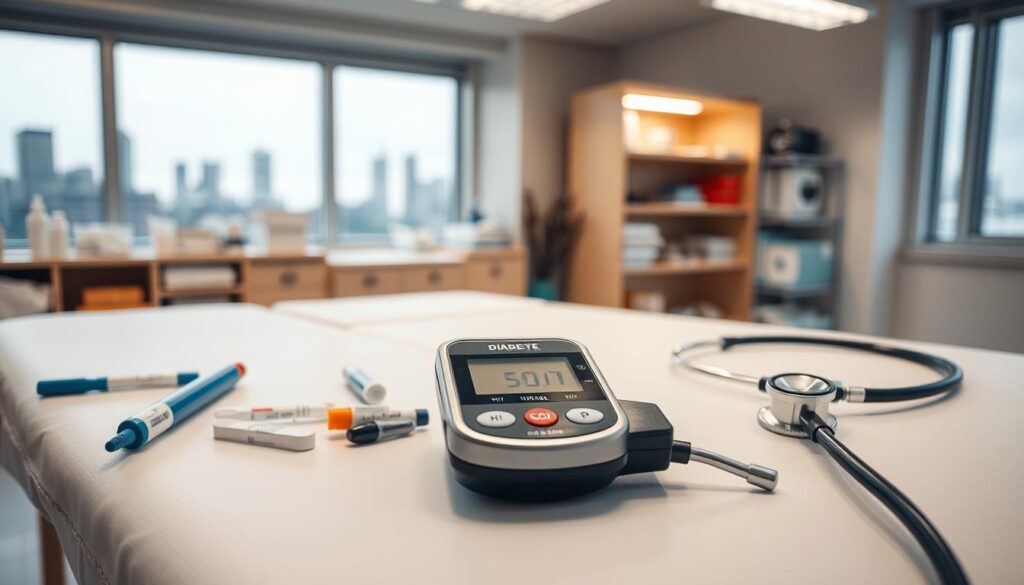Could you have diabetes without noticing the earliest signs of diabetes?
Diabetes happens when blood sugar levels get too high. This stops your body from using energy right. Both Type 1 and Type 2 diabetes show symptoms like being very thirsty, needing to pee a lot, and feeling tired.
But, many people miss these signs. Catching identify diabetes signs early can stop serious health problems. Yet, up to a third of adults with Type 2 diabetes don’t show any obvious symptoms at first.
Type 1 diabetes usually starts suddenly in kids. Type 2 develops slowly in adults. Symptoms like blurry vision or cuts that won’t heal might seem small. But ignoring them can delay getting the care you need.
Even if you have prediabetes, with diet and exercise, you can turn it around. This stops it from getting worse.
Key Takeaways
- Early signs of diabetes include increased thirst, frequent urination, and unexplained weight loss.
- Type 1 and Type 2 diabetes affect different age groups but share common symptoms.
- Many people with diabetes experience no symptoms at first, making regular check-ups vital.
- Prediabetes is reversible through lifestyle changes.
- Blurred vision or numbness in hands/feet signal high blood sugar requiring medical attention.
Understanding Diabetes: Types and Prevalence in America
Diabetes comes in different forms, each with its own causes and patterns. Knowing the signs of diabetes is important for early detection and treatment.
Type 1 vs. Type 2 Diabetes: Key Differences
Type 1 diabetes happens when the body attacks and destroys cells that make insulin. Symptoms like sudden weight loss and needing to pee a lot often show up in kids or teens. On the other hand, Type 2 diabetes is caused by the body not using insulin well. It can start slowly and may not show symptoms at first, making regular check-ups important.
| Type | Cause | Common Symptoms | U.S. Prevalence |
|---|---|---|---|
| Type 1 | Autoimmune destruction of pancreatic cells | Increased thirst, fatigue, blurred vision | ~1.6 million cases |
| Type 2 | Insulin resistance and reduced insulin production | May include slow-healing wounds, numbness, or no visible diabetes symptoms | ~34.2 million cases |
| Gestational | Pregnancy-induced insulin resistance | Frequent urination, fatigue, blurred vision | Affects 2-10% of pregnancies |
Gestational Diabetes: Temporary but Serious
Gestational diabetes is diagnosed during pregnancy and can be serious for both mom and baby. Even though it’s often temporary, it can raise the risk of diabetes later on. It’s important to keep an eye on blood sugar levels to avoid problems.
Prediabetes: The Warning Stage
Prediabetes means your blood sugar is higher than normal but not high enough to be called diabetes. Making healthy lifestyle choices can help prevent Type 2 diabetes. Getting regular blood tests is essential to catch this stage early.
What Are the Signs That You Have Diabetes?
Early diabetes warning signs often appear slowly, making them easy to miss. It’s important to recognize these symptoms early. Common recognize diabetes symptoms include:
- Increased thirst and frequent urination, often at night
- Unexplained weight loss or muscle loss
- Extreme tiredness, even after getting enough rest
- Slow-healing cuts or infections
- Blurred vision or eye discomfort
- Tingling or numbness in hands/feet (common in Type 2)

“Persistent symptoms like frequent urination and unusual thirst should prompt a blood sugar test,” states the American Diabetes Association.
Type 1 diabetes symptoms come on quickly. Type 2 symptoms may start slowly. For example, vaginal yeast infections in women or gum inflammation can signal high blood sugar. High glucose weakens the immune system, causing slow-healing sores. Blurred vision happens because of fluid shifts in the eye’s lens.
People at higher risk, like those of South Asian, African-Caribbean, or Black African heritage, should watch for symptoms closely. Even mild signs like dry skin or persistent hunger need medical check-ups. Early detection can prevent serious problems like heart disease or kidney damage.
While symptoms vary, recognize diabetes symptoms early by tracking changes in appetite, energy levels, and healing patterns. Self-assessment alone isn’t enough; only lab tests confirm the diagnosis. If you notice persistent diabetes warning signs, see a healthcare provider for accurate testing and care.
Common Early Warning Signs of Diabetes
Spotting diabetes early signs early can help a lot. Over 34 million Americans have diabetes, but many don’t notice the signs until it’s too late. It’s important to watch for signs like feeling very thirsty, tired, and changes in vision.
Increased Thirst and Frequent Urination
When blood sugar is high, kidneys work hard to get rid of it through urine. This makes you feel thirsty all the time. Also, needing to pee a lot, even at night, means your body is trying to balance sugar levels.
Unexplained Weight Loss
In type 1 diabetes, the body can’t use glucose. So, it starts breaking down fat and muscle for energy. This can cause you to lose weight quickly, even if you’re eating well.
Constant Hunger and Fatigue
When cells don’t get glucose, you feel hungry all the time. Feeling tired, even after resting, can mean your body isn’t getting the energy it needs. This could be a sign of insulin resistance or not enough insulin.
Blurred Vision
High blood sugar can make your eyes swell, changing how you see things. This blurry vision might get better if you control your blood sugar. But, you should see a doctor to be sure.
These signs of diabetes mean your body is changing in a big way. Ignoring them can lead to serious problems like nerve, kidney, or vision damage. Watching for these signs can help catch diabetes early and manage it better.
Differences in Diabetes Symptoms Between Men and Women
While both men and women experience common diabetes symptoms like frequent urination and fatigue, there are subtle differences. Knowing these differences helps us identify diabetes signs specific to each gender early on.

- Reduced muscle mass and unexplained weight loss
- Erectile dysfunction, affecting 45% of men with diabetes
Women often face unique challenges:
- More frequent yeast infections or urinary tract infections (UTIs)
- Higher risks of heart disease, kidney failure, and depression
- Polycystic ovary syndrome (PCOS), which increases type 2 diabetes risk fourfold
Women with PCOS are four times more likely to develop type 2 diabetes than those without the condition.
Women are diagnosed with type 2 diabetes earlier than men and often face worse outcomes after heart attacks. Men, on the other hand, are more likely to experience muscle loss and vascular problems like erectile dysfunction. These differences show why it’s important to tailor monitoring to each gender. Regular check-ups and sharing gender-specific symptoms with healthcare providers can lead to better outcomes.
Recognizing diabetes symptoms early on can prevent long-term complications. It’s essential for both men and women to get annual screenings and be aware of these differences.
Unique Diabetes Indicators in Children and Teens
Spotting diabetes indicators early in kids and teens can stop serious problems. Parents need to know how symptoms differ in young ones. They must act fast when they see warning signs.
Signs Parents Should Watch For
- Increased thirst and frequent urination, including bedwetting in toilet-trained children.
- Sudden weight loss despite increased appetite, paired with fatigue and irritability.
- Blurred vision, slow-healing cuts, or yeast infections in girls.
- Confusion, fruity-scented breath, or rapid breathing—signs of diabetic ketoacidosis (DKA), a life-threatening emergency.
How Diabetes Symptoms Differ in Young People
Type 1 diabetes often starts suddenly in kids, getting worse fast. The “4 Ts”—Toilet (frequent urination), Thirsty, Tired, Thinner—help spot risks. Type 2 diabetes, linked to obesity, might show fewer signs like dark skin patches or high blood sugar without symptoms.
Over 75% of kids with type 2 diabetes have a family history. Symptoms in kids need quick medical check-ups. Waiting too long can raise the risk of DKA, a serious condition.
Diabetes Warning Signs That People Often Miss
Spotting diabetes symptoms requires paying attention to small changes. Many overlook early signs of diabetes or prediabetes. These signs can show up before the usual symptoms like thirst.

Subtle Indicators That Might Surprise You
Some diabetes warning signs seem like minor issues. Here are some signs you might miss:
- Recurring yeast infections in genital areas
- Unexplained mood swings or fatigue
- Fruity-smelling breath from ketones in saliva
- Unusual tingling in hands or feet (early neuropathy)
Skin Changes as Diabetes Markers
| Symptom | Description |
|---|---|
| Acanthosis nigricans | Dark, velvety patches in skin folds (neck, armpits) |
| Necrobiosis lipoidica | Reddish-brown skin lesions on legs |
| Diabetic dermopathy | Brown scaly patches on shins or arms |
| Slow-healing wounds | Cuts or sores taking weeks to heal |
Oral Health Problems Linked to Diabetes
Gum disease and oral issues often appear before diabetes diagnosis:
- Chronic dry mouth reducing saliva production
- Slow healing after dental procedures
- Increased risk of tooth decay and gum infections
These signs need medical attention, even more so if you have a family history or obesity. Early detection is key for managing diabetes, affecting over 96 million Americans with prediabetes.
When to Seek Medical Attention for Diabetes Symptoms
If you notice signs of diabetes like extreme thirst, frequent urination, or unexplained weight loss, act fast. Early detection can prevent serious problems like nerve damage or heart disease. If you see any of these warning signs, get help right away:
- Rapid breathing or fruity-smelling breath (a sign of high ketones)
- Nausea, vomiting, or confusion
- Loss of consciousness
These symptoms might mean you have diabetic ketoacidosis, a serious condition that needs emergency care. For diabetes early signs like feeling very tired or slow-healing cuts, see a doctor within 48 hours.
| Seek Emergency Care | Schedule a Doctor Visit |
|---|---|
| Flu-like symptoms + abdominal pain | Unusual tiredness or blurred vision |
| High fever or difficulty breathing | Slow-healing sores or numbness in hands/feet |
| Confusion or extreme weakness | Increased hunger/thirst without weight gain |
If you’re over 45, overweight, or have a family history of diabetes, check your risk. Use the NHS Health Check or Diabetes UK’s Risk Calculator. The CDC suggests yearly tests for adults over 40 with risk factors. Don’t wait to get checked.
How Doctors Diagnose Diabetes: Tests and Procedures
Early diabetes diagnosis uses specific tests to check blood sugar levels. These tests help find out what type of diabetes you have. They also help doctors plan your treatment. Knowing about these steps helps you make better health choices.

Understanding Blood Glucose Tests
- Fasting Plasma Glucose (FPG): You need to fast for 8 hours. A reading of ≥126 mg/dL means you have diabetes. If it’s 100-125 mg/dL, you might have prediabetes.
- Random Blood Sugar Test: This test can be done at any time. If it shows ≥200 mg/dL and you have symptoms like needing to pee a lot or feeling tired, it could mean diabetes.
- Oral Glucose Tolerance Test (OGTT): This test checks your blood sugar before and 2 hours after drinking a sugary drink. If your 2-hour reading is ≥200 mg/dL, you have diabetes.
The A1C Test Explained
The A1C test shows your average blood sugar over 2–3 months. If your result is ≥6.5%, you have diabetes. If it’s 5.7%–6.4%, you might have prediabetes. But, this test isn’t good for checking gestational diabetes or anemia.
What to Expect During Diagnosis
Doctors often use more than one test to make sure they get the right diagnosis. Pregnant women might have a glucose challenge test to check for gestational diabetes. Tests for genes or autoantibodies can tell if you have type 1, type 2, or monogenic diabetes.
Doctors suggest screening for adults with a BMI of ≥25 (or 23 for Asian Americans) and risk factors. Or for those over 35. The results help create a treatment plan just for you. This might include using a continuous glucose monitor (CGM) to watch your blood sugar levels.
Risk Factors That Increase Your Chance of Developing Diabetes
Knowing your risk factors for diabetes can help you catch it early. This knowledge leads to making lifestyle changes. Genetics, lifestyle, and health conditions all affect your risk.
Genetic and Family History Factors
Family history is a big deal. Kids of parents with type 1 diabetes are at higher risk. For type 2, having a relative with it doubles your risk.
Also, ethnicity plays a part. African Americans, Hispanic/Latino, and Native Americans face higher rates.
Lifestyle Choices That Impact Diabetes Risk
- Being overweight/obese (BMI ≥25, 23 for Asian Americans) increases insulin resistance.
- Not being active is linked to diabetes indicators like high blood sugar.
- Eating too much sugar harms your metabolism.
- Smoking makes insulin resistance 38% worse, according to studies.
Medical Conditions Associated with Higher Diabetes Risk
| Condition | Risk Multiplier |
|---|---|
| Prediabetes | 50% higher risk |
| Non-alcoholic fatty liver disease | 40% higher risk |
| High blood pressure | 25% increased likelihood |
| Polycystic ovary syndrome (PCOS) | 2x higher risk |
Tools like the CDC’s Type 2 Diabetes Risk Test can give you a personalized look. It’s key to screen often if you’re at high risk. This includes those with certain BMI or waist sizes (men >40″, women >35″). Catching it early can stop it from getting worse.
Living with Diabetes: Next Steps After Recognizing the Signs
Spotting diabetes early signs or diabetes warning signs is key to prevention or management. Early action can lower risks of heart, kidney, and eye problems. A team of healthcare experts, including endocrinologists, dietitians, and educators, offers tailored advice.
“Understanding your diagnosis is the first step toward managing diabetes effectively.”
A proactive approach involves:
- Seeing a primary care doctor to confirm your diagnosis and create a treatment plan.
- Checking your blood glucose levels often to see how you’re doing.
- Eating a balanced diet full of veggies, whole grains, and lean proteins to keep blood sugar in check.
Regular exercise, like walking for 30 minutes a day, boosts insulin sensitivity. Don’t skip meals; eating at regular times helps keep glucose stable. Your mental health is important too; support groups or counselors can help with emotional challenges.
If you have prediabetes, making healthy lifestyle changes can reverse it. If you need medication, talk it over with your doctor to use it right. Regular check-ups and sticking to your care plan are essential for your long-term health.
Conclusion: Taking Action When You Recognize Diabetes Symptoms
Spotting diabetes symptoms early is key to getting the right care. In the U.S., millions live with diabetes, with 37.3 million diagnosed and nearly 96 million with prediabetes. Many cases go unnoticed, making it vital to catch signs like frequent urination, fatigue, or blurred vision. Early action can prevent serious problems like heart disease or nerve damage.
If you notice symptoms, act fast. Book a doctor’s visit, check your family’s health history, and learn about tests like A1C tests. Making healthy choices like regular exercise, eating right, and managing weight can help prevent type 2 diabetes. Pregnant women should also get regular check-ups for gestational diabetes.
The American Diabetes Association® provides help for those with diabetes. Donations support research and education, helping people live better lives. By knowing your risks and taking action, you can face diabetes head-on. Support research and protect your health today.
FAQ
What are the common early signs of diabetes I should look for?
Early signs of diabetes include feeling very thirsty and needing to pee a lot. You might also lose weight without trying, feel hungry all the time, and tired. Blurry vision is another sign. Catching these symptoms early is key to getting help.
How does Type 1 diabetes differ from Type 2 diabetes?
Type 1 diabetes happens when your body can’t make insulin. Type 2 diabetes means your body can make insulin but can’t use it well. This difference affects how you feel, treat, and manage the disease.
What is gestational diabetes and who is at risk?
Gestational diabetes happens during pregnancy. It can affect both mom and baby. It’s usually temporary but needs watching. Women at risk include those with a family history of diabetes, obesity, or previous gestational diabetes.
How can I identify prediabetes symptoms?
Prediabetes often doesn’t show symptoms. But, you might feel thirsty more, pee a lot, and feel tired. Knowing these signs early is important, as changing your lifestyle can stop it from becoming Type 2 diabetes.
Why does diabetes affect men and women differently?
Diabetes symptoms are similar for both men and women. But, hormonal differences can make symptoms show up differently. For example, women might get more urinary tract infections, and men might face erectile dysfunction risks.
What should parents watch for in children regarding diabetes symptoms?
Look for signs like drinking a lot of water, needing to pee a lot, and bedwetting. Also, watch for irritability and changes in behavior. Catching these symptoms early is critical, as Type 1 diabetes can develop quickly in kids.
What are some subtle signs of diabetes that are often overlooked?
Look out for mild nerve damage, mood changes, and getting sick more easily. Skin issues like acanthosis nigricans and slow healing of mouth sores can also be signs of diabetes.
When should I seek medical attention for diabetes symptoms?
See a doctor right away if you have symptoms like fast breathing, sweet-smelling breath, nausea, or vomiting. Even without symptoms, getting checked is important if you’re at risk.
What tests do doctors use to diagnose diabetes?
Doctors use tests like fasting plasma glucose, random blood glucose, and the A1C test. These tests show your blood sugar levels over three months. Doctors use these results together to make a diagnosis.
What factors increase the risk of developing diabetes?
Your risk is higher if you have a family history or certain ethnicities. Poor diet, not exercising, being overweight, and conditions like prediabetes or polycystic ovary syndrome also increase your risk.
What are the next steps if I recognize diabetes symptoms?
If you think you might have diabetes, see a doctor. Bring your family health history and questions for your doctor. This helps you manage your condition well.





